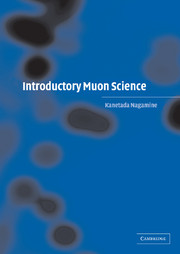Book contents
- Frontmatter
- Contents
- Preface
- List of abbreviations
- 1 What are muons? What is muon science?
- 2 Muon sources
- 3 Muons inside condensed matter
- 4 The muonic atom and its formation in matter
- 5 Muon catalyzed fusion
- 6 Muon spin rotation/relaxation/resonance: basic principles
- 7 Muon spin rotation/relaxation/resonance: probing microscopic magnetic properties
- 8 Muon spin rotation/relaxation/resonance: probing induced microscopic systems in condensed matter
- 9 Cosmic-ray muon probe for internal structure of geophysical-scale materials
- 10 Future trends in muon science
- Further reading
- Index
- References
9 - Cosmic-ray muon probe for internal structure of geophysical-scale materials
Published online by Cambridge University Press: 22 October 2009
- Frontmatter
- Contents
- Preface
- List of abbreviations
- 1 What are muons? What is muon science?
- 2 Muon sources
- 3 Muons inside condensed matter
- 4 The muonic atom and its formation in matter
- 5 Muon catalyzed fusion
- 6 Muon spin rotation/relaxation/resonance: basic principles
- 7 Muon spin rotation/relaxation/resonance: probing microscopic magnetic properties
- 8 Muon spin rotation/relaxation/resonance: probing induced microscopic systems in condensed matter
- 9 Cosmic-ray muon probe for internal structure of geophysical-scale materials
- 10 Future trends in muon science
- Further reading
- Index
- References
Summary
The spatial profile of the depth or density times length of the substance can be known by observing the manner of penetration of the energetic particle determined by electromagnetic interaction between the incoming particle and the stopping substance, which is called radiography. The most popular radiography is X-ray photography of a human body. As summarized in Table 9.1 and Figure 9.1, among various possible particles, very-high-energy (≥ 100 GeV) muon is the most suitable for measuring the density profile of a large-scale (≥ 0.1 km) substance like a mountain.
As described in Chapter 9, GeV–TeV cosmic-ray muons are constantly irradiating every substance on the earth. Muons arriving vertically from the sky have an intensity of 1 muon/cm2 per min with a mean energy of a few GeV. The potential use of such high-energy muons to explore the internal structure of large-scale objects has been recognized in the past, with the prime example being the work done by Alvarez (1970), who studied the inside of an Egyptian pyramid in order to find a hidden chamber.
Muons arriving nearly horizontally along the earth's surface with a θz slightly less than 90° have a lower intensity on average, but have a higher intensity at energies higher than a few hundreds of GeV, as can be seen in Figure 2.10.
- Type
- Chapter
- Information
- Introductory Muon Science , pp. 170 - 184Publisher: Cambridge University PressPrint publication year: 2003

